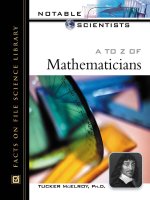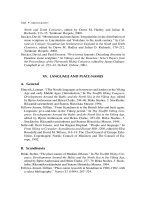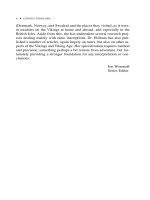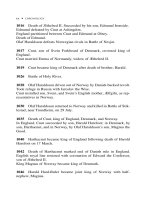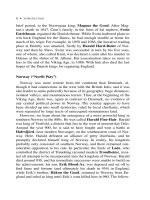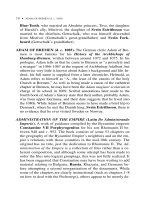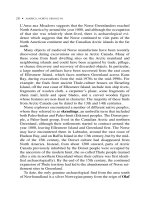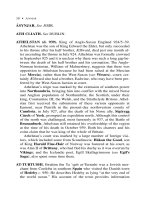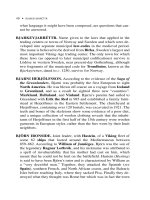A TO Z OF MATHEMATICIANS pptx
Bạn đang xem bản rút gọn của tài liệu. Xem và tải ngay bản đầy đủ của tài liệu tại đây (3.35 MB, 321 trang )
A
TO
Z
OF
M
ATHEMATICIANSNOTABLE SCIENTISTS
A
TO
Z
OF
M
ATHEMATICIANS
T
UCKER
M
C
E
LROY
, Ph.D.
A TO Z OF MATHEMATICIANS
Notable Scientists
Copyright © 2005 by Tucker McElroy, Ph.D.
All rights reserved. No part of this book may be reproduced or utilized in any form or by any
means, electronic or mechanical, including photocopying, recording, or by any information
storage or retrieval systems, without permission in writing from the publisher. For information
contact:
Facts On File, Inc.
132 West 31st Street
New York NY 10001
Library of Congress Cataloging-in-Publication Data
McElroy, Tucker.
A to Z of mathematicians / Tucker McElroy.
p. cm.—(Notable scientists)
Includes bibliographical references and index.
ISBN 0-8160-5338-3 (acid-free paper)
1. Mathematicians—Biography. I. Title. II. Series.
QA28.M395 2005
510'.92'2—dc22
2004005460
Facts On File books are available at special discounts when purchased in bulk quantities for
businesses, associations, institutions, or sales promotions. Please call our Special Sales
Department in New York at (212) 967-8800 or (800) 322-8755.
You can find Facts On File on the World Wide Web at
Text design by Joan M. Toro
Cover design by Cathy Rincon
Chronology by Sholto Ainslie
Printed in the United States of America
VB TECHBOOKS 10 9 8 7 6 5 4 3 2 1
This book is printed on acid-free paper.
C
ONTENTS
List of Entries vii
Acknowledgments ix
Introduction xi
Entries A to Z 1
Entries by Field 260
Entries by Country of Birth 262
Entries by Country of Major Scientific Activity 264
Entries by Year of Birth 266
Chronology 269
Bibliography 273
Index 291
Abel, Niels Henrik
Adelard of Bath
Agnesi, Maria Gaetana
Alembert, Jean d’
Apollonius of Perga
Archimedes of Syracuse
Aristarchus of Samos
Aryabhata I
Babbage, Charles
Bacon, Roger
Baire, René-Louis
Banach, Stefan
Barrow, Isaac
Bayes, Thomas
Bernoulli, Daniel
Bernoulli, Jakob
Bernoulli, Johann
Bessel, Friedrich Wilhelm
Betti, Enrico
Bhaskara II
Birkhoff, George David
Bolyai, János
Bolzano, Bernhard
Boole, George
Borel, Émile
Brahmagupta
Brouwer, Luitzen Egbertus Jan
Cantor, Georg
Cardano, Girolamo
Carnot, Lazare
Cartan, Élie
Cauchy, Augustin-Louis
Cavalieri, Bonaventura
Chebyshev, Pafnuty Lvovich
Ch’in Chiu-Shao
Chu Shih-Chieh
Dedekind, Richard
Democritus of Abdera
De Morgan, Augustus
Desargues, Girard
Descartes, René
Diophantus of Alexandria
Dirichlet, Gustav Peter
Lejeune
Eratosthenes of Cyrene
Euclid of Alexandria
Eudoxus of Cnidus
Euler, Leonhard
Fatou, Pierre-Joseph-Louis
Fermat, Pierre de
Ferrari, Ludovico
Ferro, Scipione del
Fibonacci, Leonardo
Fisher, Sir Ronald Aylmer
Fourier, Jean-Baptiste-Joseph
Fréchet, René-Maurice
Fredholm, Ivar
Frege, Friedrich Ludwig
Gottlob
Fubini, Guido
Galilei, Galileo
Galois, Evariste
Gauss, Carl Friedrich
Germain, Sophie
Gibbs, Josiah Willard
Gödel, Kurt Friedrich
Goldbach, Christian
Gosset, William
Grassmann, Hermann
Günter
Green, George
Gregory, James
Hamilton, Sir William Rowan
Hardy, Godfrey Harold
al-Haytham, Abu Ali
Heaviside, Oliver
Hermite, Charles
Hilbert, David
Hipparchus of Rhodes
Hippocrates of Chios
Hopf, Heinz
Huygens, Christiaan
Ibrahim ibn Sinan
Jacobi, Carl
Jordan, Camille
al-Karaji, Abu
al-Khwarizmi, Abu
Klein, Felix
Kovalevskaya, Sonya
Kronecker, Leopold
Kummer, Ernst
Lagrange, Joseph-Louis
Laplace, Pierre-Simon
L
IST OF
E
NTRIES
viii A to Z of Mathematicians
Lebesgue, Henri-Léon
Legendre, Adrien-Marie
Leibniz, Gottfried Wilhelm
von
Leonardo da Vinci
Lévy, Paul-Pierre
Li Chih
Lie, Sophus
Liouville, Joseph
Lipschitz, Rudolf
Lobachevsky, Nikolai
Lovelace, Augusta Ada Byron
Maclaurin, Colin
Madhava of Sangamagramma
Markov, Andrei
Menelaus of Alexandria
Minkowski, Hermann
Möbius, August
Moivre, Abraham de
Monge, Gaspard
Napier, John
Navier, Claude-Louis-Marie-
Henri
Newton, Sir Isaac
Noether, Emmy
Oresme, Nicole
Pappus of Alexandria
Pascal, Blaise
Peano, Giuseppe
Pearson, Egon Sharpe
Peirce, Charles
Poincaré, Jules-Henri
Poisson, Siméon-Denis
Pólya, George
Poncelet, Jean-Victor
Ptolemy, Claudius
Pythagoras of Samos
Ramanujan, Srinivasa Aiyangar
Regiomontanus, Johann
Müller
Rheticus, Georg
Riemann, Bernhard
Riesz, Frigyes
Russell, Bertrand
Seki Takakazu Kowa
Steiner, Jakob
Stevin, Simon
Stokes, George Gabriel
Tartaglia, Niccolò
Thales of Miletus
Tsu Ch’ung-Chih
Venn, John
Viète, François
Volterra, Vito
Wallis, John
Weierstrass, Karl
Weyl, Hermann
Wiener, Norbert
Yang Hui
Yativrsabha
Yule, George Udny
Zeno of Elea
Zermelo, Ernst
ix
I
thank God, who gives me strength and hope
each day. I am grateful to my wife, Autumn,
who encouraged me to complete this book.
Thanks also go to Jim Dennison for title trans-
lations, as well as Diane Kit Moser and Lisa Yount
A
CKNOWLEDGMENTS
for advice on photographs. Finally, my thanks go
to Frank K. Darmstadt, Executive Editor, for his
great patience and helpfulness, as well as the rest
of the Facts On File staff for their work in mak-
ing this book possible.
A
to Z of Mathematicians contains the fasci-
nating biographies of 150 mathematicians:
men and women from a variety of cultures, time
periods, and socioeconomic backgrounds, all of
whom have substantially influenced the history
of mathematics. Some made numerous discov-
eries during a lifetime of creative work; others
made a single contribution. The great Carl
Gauss (1777–1855) developed the statistical
method of least squares and discovered count-
less theorems in algebra, geometry, and analysis.
Sir Isaac Newton (1643–1727), renowned as the
primary inventor of calculus, was a profound re-
searcher and one of the greatest scientists of all
time. From the classical era there is Archimedes
(287
B
.
C
.
E
.–212
B
.
C
.
E
.), who paved the way for
calculus and made amazing investigations into
mechanics and hydrodynamics. These three are
considered by many mathematicians to be the
princes of the field; most of the persons in this
volume do not attain to the princes’ glory, but
nevertheless have had their share in the un-
folding of history.
T
HE
M
ATHEMATICIANS
A to Z of Mathematicians focuses on individuals
whose historical importance is firmly estab-
lished, including classical figures from the an-
cient Greek, Indian, and Chinese cultures as
well as the plethora of 17th-, 18th-, and 19th-
century mathematicians. I have chosen to
I
NTRODUCTION
exclude those born in the 20th century (with
the exception of Kurt Gödel), so that the likes
of Dame Mary Cartwright, Andrey Kolmogorov,
and John Von Neumann are omitted; this choice
reflects the opinion that true greatness is made
lucid only through the passage of time. The ear-
lier mathematicians were often scientists as well,
also contributing to astronomy, philosophy, and
physics, among other disciplines; however, the
latter persons, especially those of the 19th cen-
tury, were increasingly specialized in one partic-
ular aspect of pure or applied mathematics.
Modern figures who were principally known for
fields other than mathematics—such as Albert
Einstein and Richard Feynman—have been
omitted, despite their mathematical accom-
plishments. Being of the opinion that statistics
is one of the mathematical sciences, I have in-
cluded a smattering of great statisticians. Several
sources were consulted in order to compile a di-
verse list of persons—a list that nevertheless de-
livers the main thrust of mathematical history.
I have attempted to make this material ac-
cessible to a general audience, and as a result the
mathematical ideas are presented in simple
terms that cut to the core of the matter. In some
cases precision was sacrificed for accessibility.
However, due to the abstruse nature of 19th- and
20th-century mathematics, many readers may
still have difficulty. I suggest that they refer to
Facts On File’s handbooks in algebra, calculus,
xii A to Z of Mathematicians
and geometry for unfamiliar terminology. It
is helpful for readers to have knowledge of
high school geometry and algebra, as well as
calculus.
After each entry, a short list of additional
references for further reading is provided. The
majority of the individuals can be found in
the Dictionary of Scientific Biography (New York,
1970–90), the Encyclopaedia Britannica (http://
www.eb.com), and the online MacTutor History
of Mathematics archive (.
st-and.ac.uk/~history); so these references have
not been repeated each time. In compiling
references I tried to restrict sources to those
articles written in English that were easily ac-
cessible to college undergraduates.
A
1
ᨳ
Abel, Niels Henrik
(1802–1829)
Norwegian
Algebra
The modest Norwegian mathematician Niels
Abel made outstanding contributions to the the-
ory of elliptic functions, one of the most popu-
lar mathematical subjects of the 19th century.
Struggle, hardship, and uncertainty character-
ized his life; but under difficult conditions he still
managed to produce a prolific and brilliant body
of mathematical research. Sadly, he died young,
without being able to attain the glory and recog-
nition for which he had labored.
Niels Henrik Abel was born the son of
Sören Abel, a Lutheran pastor, and Ane Marie
Simonson, the daughter of a wealthy merchant.
Pastor Abel’s first parish was in the island of
Finnöy, where Niels Abel was born in 1802.
Shortly afterward, Abel’s father became in-
volved in politics.
Up to this time Abel and his brothers had
received instruction from their father, but in
1815 they were sent to school in Oslo. Abel’s
performance at the school was marginal, but in
1817 the arrival of a new mathematics teacher,
Bernt Holmboe, greatly changed Abel’s fate.
Holmboe recognized Abel’s gift for mathemat-
ics, and they commenced studying
LEONHARD
EULER
and the French mathematicians. Soon
Abel had surpassed his teacher. At this time he
was greatly interested in the theory of algebraic
equations. Holmboe was delighted with his dis-
covery of the young mathematician, and he en-
thusiastically acquainted the other faculty with
the genius of Abel.
During his last year at school Abel at-
tempted to solve the quintic equation, an out-
standing problem from antiquity; but he failed
(the equation has no rational solutions).
Nevertheless, his efforts introduced him to the
theory of elliptic functions. Meanwhile, Abel’s
father fell into public disgrace due to alcoholism,
and after his death in 1820 the family was left
in difficult financial circumstances.
Abel entered the University of Sweden in
1821, and was granted a free room due to his ex-
treme poverty. The faculty even supported him
out of its own resources; he was a frequent guest
of the household of Christoffer Hansteen, the
leading scientist at the university. Within the
first year, Abel had completed his preliminary
degree, allowing him the time to pursue his own
advanced studies. He voraciously read every-
thing he could find concerning mathematics,
and published his first few papers in Hansteen’s
journal after 1823.
In summer 1823 Abel received assistance
from the faculty to travel to Copenhagen, in
2 Abel, Niels Henrik
order to meet the Danish mathematicians. The
trip was inspirational; he also met his future fi-
ancée, Christine Kemp. When he returned to
Oslo, Abel began work on the quintic equation
once again, but this time, he attempted to prove
that there was no radical expression for the so-
lution. He was successful, and had his result pub-
lished in French at his own expense. Sadly, there
was no reaction from his intended audience—
even
CARL FRIEDRICH GAUSS
was indifferent.
Abel’s financial problems were complicated
by his engagement to Kemp, but he managed to
secure a small stipend to study languages in
preparation for travel abroad. After this, he
would receive a modest grant for two years of
foreign study. In 1825 he departed with some
friends for Berlin, and on his way through
Copenhagen made the acquaintance of August
Crelle, an influential engineer with a keen in-
terest for mathematics. The two became lifelong
friends, and Crelle agreed to start a German jour-
nal for the publication of pure mathematics.
Many of Abel’s papers were published in the first
volumes, including an expanded version of his
work on the quintic.
One of Abel’s notable papers in Crelle’s
Journal generalized the binomial formula, which
gives an expansion for the nth power of a bino-
mial expression. Abel turned his thought toward
infinite series, and was concerned that the sums
had never been stringently determined. The re-
sult of his research was a classic paper on power
series, with the determination of the sum of the
binomial series for arbitrary exponents.
Meanwhile, Abel failed to obtain a vacant po-
sition at the University of Sweden; his former
teacher Holmboe was instead selected. It is note-
worthy that Abel maintained his nobility of
character throughout his frustrating life.
In spring 1826 Abel journeyed to Paris and
presented a paper to the French Academy of
Sciences that he considered his masterpiece: It
treated the sum of integrals of a given algebraic
function, and thereby generalized Euler’s relation
for elliptic integrals. This paper, over which Abel
labored for many months but never published,
was presented in October 1826, and
AUGUSTIN
-
LOUIS CAUCHY
and
ADRIEN
-
MARIE LEGENDRE
were
appointed as referees. A report was not forth-
coming, and was not issued until after Abel’s
death. It seems that Cauchy was to blame for the
tardiness, and apparently lost the manuscript.
Abel later rewrote the paper (neither was this
work published), and the theorem described
above came to be known as Abel’s theorem.
After this disappointing stint in France,
Abel returned to Berlin and there fell ill with
his first attack of tuberculosis. Crelle assisted
him with his illness, and tried to procure a po-
sition for him in Berlin, but Abel longed to re-
turn to Norway. Abel’s new research transformed
Niels Abel, one of the founders of the theory of
elliptic functions, a generalization of trigonometric
functions (Courtesy of the Library of Congress)
Adelard of Bath 3
the theory of elliptic integrals to the theory of
elliptic functions by using their inverses.
Through this duality, elliptic functions became
an important generalization of trigonometric
functions. As a student in Oslo, Abel had al-
ready developed much of the theory, and this pa-
per presented his thought in great detail.
Upon his return to Oslo in 1827, Abel had
no prospects of a position, and managed to sur-
vive by tutoring schoolboys. In a few months
Hansteen went on leave to Siberia and Abel be-
came his substitute at the university. Meanwhile,
Abel’s work had started to stimulate interest
among European mathematicians. In early 1828
Abel discovered that he had a young German
competitor,
CARL JACOBI
, in the field of elliptic
functions. Aware of the race at hand, Abel wrote
a rapid succession of papers on elliptic functions
and prepared a book-length memoir that would
be published posthumously.
It seems that Abel had the priority of dis-
covery over Jacobi in the area of elliptic func-
tions; however, it is also known that Gauss was
aware of the principles of elliptic functions long
before either Abel or Jacobi, and had decided
not to publish. At this time Abel started a cor-
respondence with Legendre, who was also inter-
ested in elliptic functions. The mathematicians
in France, along with Crelle, attempted to se-
cure employment for Abel, and even petitioned
the monarch of Sweden.
Abel’s health was deteriorating, but he con-
tinued to write papers frantically. He spent sum-
mer 1828 with his fiancée, and when visiting her
at Christmastime he became feverish due to ex-
posure to the cold. As he prepared for his return
to Oslo, Abel suffered a violent hemorrhage, and
was confined to bed. At the age of 26 he died
of tuberculosis on April 26, 1829; two days later,
Crelle wrote him jubilantly that he had secured
Abel an appointment in Berlin. In 1830 the
French Academy of Sciences awarded its Grand
Prix to Abel and Jacobi for their brilliant math-
ematical discoveries.
Abel became recognized as one of the great-
est mathematicians after his death, and he truly
accomplished much despite his short lifespan.
The theory of elliptic functions would expand
greatly during the later 19th century, and Abel’s
work contributed significantly to this develop-
ment.
Further Reading
Bell, E. Men of Mathematics. New York: Simon and
Schuster, 1965.
Ore, O. Niels Henrik Abel, Mathematician Extraordi-
nary. Minneapolis: University of Minnesota
Press, 1974.
Rosen, M. I. “Niels Henrik Abel and the Equation of
the Fifth Degree,” American Mathematical Monthly
102 (1995): 495–505.
Stander, D. “Makers of Modern Mathematics: Niels
Henrik Abel,” Bulletin of the Institute of Mathemat-
ics and Its Applications 23, nos. 6–7 (1987): 107–
109.
ᨳ Adelard of Bath
(unknown–ca. 1146)
British
Arithmetic
Little is known of the personal life of Adelard
of Bath, but his work has been of great impor-
tance to the early revival of mathematics and
natural philosophy during the medieval period.
His translation of Greek and Arabic classics
into Latin enabled the knowledge of earlier so-
cieties to be preserved and disseminated in
Europe.
Adelard was a native of Bath, England, but
his exact birth date is not known. He traveled
widely in his life, first spending time in France,
where he studied at Tours. For the next seven
years he journeyed afar, visiting Salerno, Sicily,
Cilicia, Syria, and perhaps even Palestine; it is
thought that he also dwelt in Spain. His latter
travels gave him an acquaintance with Arabic
4 Agnesi, Maria Gaetana
language and culture, though he may have
learned Arabic while still in Sicily. By 1130 he
had returned to Bath, and his writings from that
time have some association with the royal court.
One of his works, called Astrolabe, was appar-
ently composed between 1142 and 1146; this is
the latest recorded date of his activity.
Adelard made two contributions—De eo-
dem et diverso (On sameness and diversity) and
the Questiones naturales (Natural questions)—
to medieval philosophy, written around 1116
and 1137, respectively. In De eodem et diverso,
there is no evidence of Arabic influence, and
he expresses the views of a quasi-Platonist. The
Questiones naturales treats various topics in nat-
ural philosophy and shows the impact of his
Arabic studies. Adelard’s contribution to me-
dieval science seems to lie chiefly in his trans-
lation of various works from Arabic.
His early endeavors in arithmetic, published
in Regule abaci (By rule of the abacus), were quite
traditional—his work reflected current arith-
metical knowledge in Europe. These writings
were doubtlessly composed prior to his familiar-
ity with Arabic mathematics. Adelard also wrote
on the topics of arithmetic, geometry, music, and
astronomy. Here, the subject of Indian numer-
als and their basic operations is introduced as of
fundamental importance.
Many scholars believe that Adelard was the
first translator to present a full Latin version of
EUCLID OF ALEXANDRIA
’s Elements. This began
the process whereby the Elements would come to
dominate late medieval mathematics; prior to
Adelard’s translation from the Arabic, there
were only incomplete versions taken from the
Greek. The first version was a verbatim tran-
scription from the Arabic, whereas Adelard’s
second version replaces some of the proofs with
instructions or summaries. This latter edition be-
came the most popular, and was most commonly
studied in schools. A third version appears to be
a commentary and is attributed to Adelard; it
enjoyed some popularity as well.
All the later mathematicians of Europe
would read Euclid, either in Latin or Greek; in-
deed, this compendium of geometric knowledge
would become a staple of mathematical education
up to the present time. The Renaissance, and the
consequent revival of mathematical discovery,
was only made possible through the rediscovery
of ancient classics and their translations. For his
work as a translator and commentator, Adelard
is remembered as an influential figure in the his-
tory of mathematics.
Further Reading
Burnett, C. Adelard of Bath: An English Scientist and
Arabist of the Early Twelfth Century. London:
Warburg Institute, University of London, 1987.
ᨳ Agnesi, Maria Gaetana
(1718–1799)
Italian
Algebra, Analysis
Maria Gaetana Agnesi is known as a talented
mathematician of the 18th century, and indeed
was one of the first female mathematicians in
the Western world. A mathematical prodigy
with great linguistic talents, Agnesi made her
greatest contribution through her clear exposi-
tion of algebra, geometry, and calculus; her col-
leagues acknowledged the value of her work
within her own lifetime.
Born the eldest child of Pietro Agnesi and
Anna Fortunato Brivio, Agnesi showed early in-
terest in science. Her father, a wealthy professor
of mathematics at the University of Bologna, en-
couraged and developed these interests. He estab-
lished a cultural salon in his home, where his
daughter would present and defend theses on a va-
riety of scientific and philosophical topics. Some
of the guests were foreigners, and Maria demon-
strated her talent for languages by conversing with
them in their own tongue; by age 11 she was fa-
miliar with Greek, German, Spanish, and Hebrew,
Agnesi, Maria Gaetana 5
having already mastered French by age five. At
age nine she prepared a lengthy speech in Latin
that promulgated higher education for women.
The topics of these theses, which were usu-
ally defended in Latin, included logic, ontology,
mechanics, hydromechanics, elasticity, celestial
mechanics and universal gravitation, chemistry,
botany, zoology, and mineralogy. Her second
published work, the Propositiones philosophicae
(Propositions of philosophy, 1738), included al-
most 200 of these disputations. Agnesi’s mathe-
matical interests were developing at this time;
at age 14 she was solving difficult problems in
ballistics and analytic geometry. But after the
publication of the Propositiones philosophicae, she
decided to withdraw from her father’s salon,
since the social atmosphere was unappealing to
her—in fact, she was eager to join a convent,
but her father dissuaded her.
Nevertheless, Agnesi withdrew from the ex-
troverted social life of her childhood, and devoted
the next 10 years of her life to mathematics.
After a decade of intense effort, she produced
her Instituzioni analitiche ad uso della gioventù ital-
iana (Analytical methods for the use of young
Italians) in 1748. The two-volume work won im-
mediate praise among mathematicians and
brought Agnesi public acclaim. The objective of
the thousand-page book was to present a com-
plete and comprehensive treatment of algebra
and analysis, including and emphasizing the new
concepts of the 18th century. Of course, the de-
velopment of differential and integral calculus
was still in progress at this time; Agnesi would
incorporate this contemporary mathematics into
her treatment of analysis.
The material spanned elementary algebra
and the classical theory of equations, coordinate
geometry, the differential and integral calculus,
infinite series, and the solution of elementary
differential equations. Many of the methods and
results were due solely to Agnesi, although her
humble nature made her overly thorough in giv-
ing credit to her predecessors. Her name is of-
ten associated with a certain cubic curve called
the versiera and known more commonly as the
“witch of Agnesi.” She was unaware that
PIERRE
DE FERMAT
had studied the equation previously
in 1665. This bell-shaped curve has many in-
teresting properties and some applications in
physics, and has been an ongoing source of fas-
cination for many mathematicians.
Agnesi’s treatise received wide acclaim for
its excellent treatment and clear exposition.
Translations into French and English from the
original Italian were considered to be of great
importance to the serious student of mathemat-
ics. Pope Benedict XIV sent her a congratula-
tory note in 1749, and in 1750 she was appointed
to the chair of mathematics and natural philos-
ophy at the University of Bologna.
However, Agnesi’s reclusive and humble
personality led her to accept the position only
in honor, and she never actually taught at the
university. After her father’s death in 1752, she
Maria Agnesi studied the bell-shaped cubic curve called
the versiera, which is more commonly known as the
“witch of Agnesi.” (Courtesy of the Library of Congress)
6 Alembert, Jean d’
began to withdraw from all scientific activity—
she became more interested in religious studies
and social work. She was particularly con-
cerned with the poor, and looked after the ed-
ucation of her numerous younger brothers. By
1762 she was quite removed from mathemat-
ics, so that she declined the University of
Turin’s request that she act as referee for
JOSEPH
-
LOUIS LAGRANGE
’s work on the calculus of vari-
ations. In 1771 Agnesi became the director of
a Milanese home for the sick, a position she
held until her death in 1799.
It is interesting to note that the sustained
activity of her intellect over 10 years was able
to produce the Instituzioni, a work of great ex-
cellence and quality. However, she lost all in-
terest in mathematics soon afterward and made
no further contributions to that discipline.
Agnesi’s primary contribution to mathematics is
the Instituzioni, which helped to disseminate
mathematical knowledge and train future gen-
erations of mathematicians.
Further Reading
Grinstein, L., and P. Campbell. Women of Mathematics.
New York: Greenwood Press, 1987.
Truesdell, C. “Correction and Additions for Maria
Gaetana Agnesi,” Archive for History of Exact
Science 43 (1991): 385–386.
ᨳ Alembert, Jean d’ (Jean Le Rond
d’Alembert)
(1717–1783)
French
Mechanics, Calculus
In the wave of effort following
SIR ISAAC NEW
-
TON
’s pioneering work in mechanics, many
mathematicians attempted to flesh out the
mathematical aspects of the new science. Jean
d’Alembert was noteworthy as one of these in-
tellectuals, who contributed to astronomy, fluid
mechanics, and calculus; he was one of the first
persons to realize the importance of the limit in
calculus.
Jean Le Rond d’Alembert was born in Paris
on November 17, 1717. He was the illegitimate
son of a famous salon hostess and a cavalry offi-
cer named Destouches-Canon. An artisan named
Rousseau raised the young d’Alembert, but his
father oversaw his education; he attended a
Jansenist school, where he learned the classics,
rhetoric, and mathematics.
D’Alembert decided on a career as a math-
ematician, and began communicating with the
Académie des Sciences in 1739. During the next
few years he wrote several papers treating the in-
tegration of differential equations. Although he
had no formal training in higher mathematics,
Jean d’Alembert formulated several laws of motion,
including d’Alembert’s principle for decomposing
constrained motions. (Courtesy of the National Library
of Medicine)
Alembert, Jean d’ 7
d’Alembert was familiar with the works of
Newton, as well as the works of
JAKOB BERNOULLI
and
JOHANN BERNOULLI
.
In 1741 he was made a member of the
Académie, and he concentrated his efforts on
some problems in rational mechanics. The Traité
de dynamique (Treatise on dynamics) was the
fruit of his labor, a significant scientific work that
formalized the new science of mechanics. The
lengthy preface disclosed d’Alembert’s philoso-
phy of sensationalism (this idea states that sense
perception, not reason, is the starting point for
the acquisition of knowledge). He developed
mechanics from the simple concepts of space and
time, and avoided the notion of force.
D’Alembert also presented his three laws of mo-
tion, which treated inertia, the parallelogram
law of motion, and equilibrium. It is noteworthy
that d’Alembert produced mathematical proofs
for these laws.
The well-known d’Alembert’s principle was
also introduced in this work, which states that
any constrained motion can be decomposed in
terms of its inertial motion and a resisting (or
constraining) force. He was careful not to over-
value the impact of mathematics on physics—
he said that geometry’s rigor was tied to its sim-
plicity. Since reality was always more complicated
than a mathematical abstraction, it is more diffi-
cult to establish truth.
In 1744 he produced a new volume called
the Traité de l’équilibre et du mouvement des fluides
(Treatise on the equilibrium and movement of
fluids). In the 18th century a large amount of
interest focused on fluid mechanics, since fluids
were used to model heat, magnetism, and elec-
tricity. His treatment was different from that of
DANIEL BERNOULLI
, though the conclusions were
similar. D’Alembert also examined the wave
equation, considering string oscillation problems
in 1747. Then in 1749 he turned toward celestial
mechanics, publishing the Recherches sur la pré-
cession des équinoxes et sur la nutation de l’axe de la
terre (Research on the precession of the equinoxes and
on the nodding of the earth’s axis), which treated
the topic of the gradual change in the position
of the earth’s orbit.
Next, d’Alembert competed for a prize at
the Prussian Academy, but blamed
LEONHARD
EULER
for his failure to win. D’Alembert published
his Essai d’une nouvelle théorie de la résistance des
fluides (Essay on a new theory of the resistance of
fluids) in 1752, in which the differential hydro-
dynamic equations were first expressed in terms
of a field. The so-called hydrodynamic paradox
was herein formulated—namely, that the flow
before and behind an obstruction should be the
same, resulting in the absence of any resistance.
D’Alembert did not solve this problem, and was
to some extent inhibited by his bias toward con-
tinuity; when discontinuities arose in the solu-
tions of differential equations, he simply threw
the solution away.
In the 1750s, interested in several nonsci-
entific topics, d’Alembert became the science
editor of the Encyclopédie (Encyclopedia). Later
he wrote on the topics of music, law, and reli-
gion, presenting himself as an avid proponent of
Enlightenment ideals, including a disdain for
medieval thought.
Among his original contributions to math-
ematics, the ratio test for the convergence of an
infinite series is noteworthy; d’Alembert viewed
divergent series as nonsensical and disregarded
them (this differs markedly from Euler’s view-
point). D’Alembert was virtually alone in his
view of the derivative as the limit of a function,
and his stress on the importance of continuity
probably led him to this perspective. In the the-
ory of probability d’Alembert was quite handi-
capped, being unable to accept standard solutions
of gambling problems.
D’Alembert was known to be a charming,
witty man. He never married, although he lived
with his lover Julie de Lespinasse until her death
in 1776. In 1772 he became the secretary of the
Académie Française (the French Academy), and
he increasingly turned toward humanitarian
8 Apollonius of Perga
concerns. His later years were marked by bitter-
ness and despair; he died in Paris on October 29,
1783.
Although he was well known as a preemi-
nent scientist and philosopher, d’Alembert’s
mathematical achievements deserve special
recognition. He greatly advanced the theory of
mechanics in several of its branches, by con-
tributing to its mathematical formulation and by
consideration of several concrete problems.
Further Reading
Grimsley, R. Jean d’Alembert, 1717–83. Oxford: Claren-
don Press, 1963.
Hankins, T. Jean d’Alembert: Science and the
Enlightenment. Oxford: Clarendon Press, 1970.
Pappas, J. Voltaire and d’Alembert. Bloomington:
Indiana University Press, 1962.
Wilson, C. “D’Alembert versus Euler on the
Precession of the Equinoxes and the Mechanics
of Rigid Bodies,” Archive for History of Exact
Sciences 37, no. 3 (1987): 233–273.
ᨳ Apollonius of Perga
(ca. 262
B
.
C
.
E
.–190
B
.
C
.
E
.)
Greek
Geometry
Greek mathematics continued its development
from the time of
EUCLID OF ALEXANDRIA
, and af-
ter
ARCHIMEDES OF SYRACUSE
one of the greatest
mathematicians was Apollonius of Perga. He is
mainly known for his contributions to the the-
ory of conic sections (those plane figures ob-
tained by slicing a cone at various angles). The
fascination in this subject, revived in the 16th
and 17th centuries, has continued into modern
times with the onset of projective geometry.
Little information on his life has been pre-
served from the ravages of time, but it seems that
Apollonius flourished sometime between the
second half of the third century and the early
second century
B
.
C
.
E
. Perga, a small Greek city
in the southern portion of what is now Turkey,
was his town of birth. Apollonius dwelt for some
time in Alexandria, where he may have studied
with the pupils of Euclid, and he later visited
both Pergamum and Ephesus.
His most famous work, the Conics, was com-
posed in the early second century
B
.
C
.
E
., and it
soon became recognized as a classic text.
Archimedes, who died around 212
B
.
C
.
E
., ap-
pears to be the immediate mathematical prede-
cessor of Apollonius, who developed many of the
Syracusan’s ideas. The Conics was originally di-
vided into eight books, and had been intended
as a treatise on conic sections. Before Apollonius’s
time, the basics of the theory of conic sections
were known: Parabolas, hyperbolas, and ellipses
could be obtained by appropriately slicing a cone
with right, obtuse, or acute vertex angles, re-
spectively. Apollonius employed an alternative
method of construction that involved slicing a
double cone at various angles, keeping the ver-
tex angle fixed (this is the approach taken in
modern times). This method had the advantage
of making these curves accessible to the “appli-
cation of areas,” a geometrical formulation of
quadratic equations that in modern time would
be expressed algebraically. It is apparent that
Apollonius’s approach was refreshingly origi-
nal, although the actual content of the Conics
may have been well known. Much terminology,
such as parabola, hyperbola, and ellipse, is due to
Apollonius, and he generalizes the methods for
generating sections.
The Conics contains much material that was
already known, though the organization was ac-
cording to Apollonius’s method, which smoothly
joined together numerous fragments of geomet-
rical knowledge. Certain elementary results were
omitted, and some few novel facts were included.
Besides the material on the generation of sections,
Apollonius described theorems on the rectangles
contained by the segments of intersecting chords
of a conic, the harmonic properties of pole and
polar, properties of the focus, and the locus of
Apollonius of Perga 9
three and four lines. He discusses the formation
of a normal line to a conic, as well as certain in-
equalities of conjugate diameters. This work,
compared with other Greek literature, is quite
difficult to read, since the lack of modern nota-
tion makes the text burdensome, and the content
itself is quite convoluted. Nevertheless, persistent
study has rewarded many gifted mathematicians,
including
SIR ISAAC NEWTON
,
PIERRE DE FERMAT
,
and
BLAISE PASCAL
, who drew enormous inspi-
ration from Apollonius’s classic text.
In the work of
PAPPUS OF ALEXANDRIA
is con-
tained a summary of Apollonius’s other mathe-
matical works: Cutting off of a Ratio, Cutting off
of an Area, Determinate Section, Tangencies,
Inclinations, and Plane Loci. These deal with var-
ious geometrical problems, and some of them in-
volve the “application of an area.” He uses the
Greek method of analysis and synthesis: The
problem in question is first presumed solved, and
a more easily constructed condition is deduced
from the solution (“analysis”); then from the lat-
ter construction, the original is developed (“syn-
thesis”). It seems that Apollonius wrote still
other documents, but no vestige of their content
has survived to the present day. Apparently, he
devised a number system for the representation
of enormous quantities, similar to the notational
system of Archimedes, though Apollonius gen-
eralized the idea. There are also references to the
inscribing of the dodecahedron in the sphere,
the study of the cylindrical helix, and a general
treatise on the foundations of geometry.
So Apollonius was familiar with all aspects
of Greek geometry, but he also contributed to
the Euclidean theory of irrational numbers and
derived approximations for pi more accurate
than Archimedes’. His thought also penetrated
the science of optics, where his deep knowledge
of conics assisted the determination of various
reflections caused by parabolic and spherical
mirrors. Apollonius was renowned in his own
time as a foremost astronomer, and he even
earned the epithet of Epsilon, since the Greek
letter of that name bears a resemblance in shape
to the Moon. He calculates the distance of Earth
to Moon as roughly 600,000 miles, and made
various computations of the orbits of the plan-
ets. In fact, Apollonius is an important player in
the development of geometrical models to ex-
plain planetary motion;
HIPPARCHUS OF RHODES
and
CLAUDIUS PTOLEMY
, improving upon his the-
ories, arrived at the Ptolemaic system, a feat of
the ancient world’s scientific investigation pos-
sessed of sweeping grandeur and considerable
longevity.
There was no immediate successor to
Apollonius, though his Conics was recognized as
a superb accomplishment. Various simple com-
mentaries were produced, but interest declined
after the fall of Rome, and only the first four
books continued to be translated in Byzantium.
Another three books of the Conics were trans-
lated into Arabic, and Islamic mathematicians
remained intrigued by his work, though they
made few advancements; the final (eighth) book
has been lost. In the late 16th and early 17th
centuries, several translations of Apollonius’s
Conics appeared in Europe and were voraciously
studied by French mathematicians such as
RENÉ
DESCARTES
, Pierre de Fermat,
GIRARD DESARGUES
,
and Blaise Pascal. When Descartes propounded
his analytic geometry, which took an algebraic,
rather than constructive or geometrical, ap-
proach to curves and sections, interest in
Apollonius’s classic treatise began to wane.
However, later in the 19th century, the Conics
experienced a resurrection of curiosity with the
introduction of projective geometry.
Further Reading
Heath, T. Treatise on Conic Section. New York: Barnes
& Noble, 1961.
———. A History of Greek Mathematics. Oxford:
Clarendon Press, 1921.
Hogendijk, J. “Arabic Traces of Lost Works of
Apollonius,” Archive for History of Exact Sciences
35, no. 3 (1986): 187–253.
10 Archimedes of Syracuse
ᨳ
Archimedes of Syracuse
(ca. 287
B
.
C
.
E
.–212
B
.
C
.
E
.)
Greek
Geometry, Mechanics
Of the mathematicians of Greek antiquity,
Archimedes should be considered the greatest.
His contributions to geometry and mechanics,
as well as hydrostatics, place him on a higher
pedestal than his contemporaries. And as his
works were gradually translated and introduced
into the West, he exerted as great an influence
there as his thought already had in Byzantium
and Arabia. In his method of exhaustion can be
seen a classical predecessor of the integral cal-
culus, which would be formally developed by
BLAISE PASCAL
,
GOTTFRIED WILHELM VON LEIBNIZ
,
SIR ISAAC NEWTON
, and others in the 17th cen-
tury. His life story alone has inspired many
mathematicians.
As with many ancient persons, the exact de-
tails of Archimedes’ life are difficult to ascertain,
since there are several accounts of variable qual-
ity. His father was the astronomer Phidias, and
it is possible that Archimedes was a kinsman of
the tyrant of Syracuse, King Hieron II. Certainly
he was intimate with the king, as his work The
Sandreckoner was dedicated to Hieron’s son
Gelon. Born in Syracuse, Archimedes departed
to Alexandria in order to pursue an education
in mathematics; there he studied
EUCLID OF
ALEXANDRIA
and assisted the development of
Euclidean mathematics. But it was in Syracuse,
where he soon returned, that he made most of
his discoveries.
Although renowned for his contributions to
mathematics, Archimedes also designed numer-
ous mechanical inventions. The water snail, in-
vented in Egypt to aid irrigation, was a screwlike
contraption used to raise water. More impressive
are the stories relating his construction and ap-
plication of the compound pulley: Hieron had re-
quested Archimedes to demonstrate how a small
force could move a large weight. The mathe-
matician attached a rope to a large merchant ship
that was loaded with freight and passengers, and
ran the line through a system of pulleys. In this
manner, seated at a distance from the vessel,
Archimedes was able to effortlessly draw the boat
smoothly off the shore into the harbor.
Similar to the pulley, Archimedes discovered
the usefulness of the lever, noting that the longer
the distance from the fulcrum, the more weight the
lever could move. Logically extending this prin-
ciple, he asserted that it was feasible to move the
world, given a sufficiently long lever. Another
popular story relates that Hieron gave Archi-
medes the task of ascertaining whether a certain
crown was made of pure gold, or whether it had
been fraudulently alloyed with silver. As
Archimedes pondered this puzzle, he came upon
the bath, and noticed that the amount of water
Archimedes is the great Greek mathematician who
formulated the principles of hydromechanics and
invented early techniques of integral calculus.
(Courtesy of the National Library of Medicine)
Archimedes of Syracuse 11
displaced was equal to the amount of his body
that was immersed. This immediately put him in
mind of a method to solve Hieron’s problems,
and he leapt out of the tub in joy, running naked
toward his home, shrieking “Eureka!”
His skill in mechanical objects was un-
equaled, and Hieron often put him to use in im-
proving the defenses of the city, insisting that
Archimedes’ intellect should be put to some
practical application. When Marcellus and the
Romans later came to attack Syracuse, they
found the city impregnable due to the multi-
plicity of catapults, mechanical arms, burning
mirrors, and various ballistic devices that
Archimedes had built. Archimedes wrote a book
entitled On Spheremaking, in which he describes
how to construct a model planetarium designed
to simulate the movement of Sun, Moon, and
planets. It seems that Archimedes was familiar
with Archytas’s heliocentrism, and made use of
this in his planetarium.
According to Plutarch, Archimedes was
dedicated to pure theory and disdained the prac-
tical applications of mathematics to engineering;
only those subjects free of any utility to society
were considered worthy of wholehearted pursuit.
Archimedes’ mathematical works consist mainly
of studies of area and volume, and the geomet-
rical analysis of statics and hydrostatics. In com-
puting the area or volume of various plane and
solid figures, he makes use of the so-called
Lemma of Archimedes and the “method of ex-
haustion.” This lemma states that the difference
of two unequal magnitudes can be formed into
a ratio with any similar magnitude; thus, the dif-
ference of two lines will always be a line and not
a point. The method of exhaustion involves sub-
tracting a quantity larger than half of a given
magnitude indefinitely, and points to the idea of
the eternal divisibility of the continuum (that
one can always take away half of a number and
still have something left). These ideas border on
notions of the infinitesimal—the infinitely
small—and the idea of a limit, which are key
ingredients of integral calculus; however, the
Greeks were averse to the notion of infinity and
infinitesimals, and Archimedes shied away from
doing anything that he felt would be regarded as
absurd.
The method of exhaustion, which was used
rarely in Euclid’s Elements, will be illustrated
through the following example: In On the
Measurement of the Circle, Archimedes assumes,
for the sake of contradiction, that the area of a
right triangle with base equal to the circumfer-
ence and height equal to the radius of the circle
is actually greater than the area of the circle.
Then he is able, using the Lemma of Archimedes,
to inscribe a polygon in the circle, with the same
area as the triangle; this contradiction shows that
the area of the triangle cannot be greater than
the circle, and he makes a similar argument that
it cannot be less.
The basic concept of the method of ap-
proximation, which is similar to the method of
exhaustion, is to inscribe regular figures within
a given plane figure and solid such that the re-
maining area or volume is steadily reduced; the
area or volume of the regular figures can be eas-
ily calculated, and this will be an increasingly
accurate approximation. The remaining area or
volume is “exhausted.” Of course, the modern
way to obtain an exact determination of meas-
ure is via the limit; Archimedes avoided this is-
sue by demonstrating that the remaining area or
volume could be made as small as desired by in-
scribing more regular figures. Of course, one
could perform the same procedure with circum-
scribing regular figures.
He also applied these methods to solids,
computing the surface area and volume of the
sphere, and the volume of cones and pyramids.
Archimedes’ methods were sometimes purely
geometrical, but at times used principles from
statics, such as a “balancing method.” His knowl-
edge of the law of the lever and the center of
gravity for the triangle, together with his ap-
proximation and exhaustion methods, enabled
12 Aristarchus of Samos
him to improve the proofs of known theorems
as well as establish completely new results.
Archimedes also made some contributions in
the realm of numerical calculations, producing
some highly accurate approximations for pi and
the square root of three. In The Sandreckoner he
devises a notation for enormous numbers and es-
timates the number of grains of sand to fill the
universe. In On the Equilibrium of Planes he proves
the law of the lever from geometrical principles,
and in On Floating Bodies he explains the con-
cept of hydrostatic pressure. The so-called
Principle of Archimedes states that solids placed
in a fluid will be lighter in the fluid by an amount
equal to the weight of the fluid displaced.
His influence on later mathematics was ex-
tensive, although Archimedes may not have en-
joyed much fame in his own lifetime. Later
Greeks, including
PAPPUS OF ALEXANDRIA
and
Theon of Alexandria, wrote commentaries on
his writings, and later still, Byzantine authors
studied his work. From Byzantium his texts came
into the West before the start of the Renaissance;
meanwhile, Arabic mathematicians were familiar
with Archimedes, and they exploited his meth-
ods in their own researches into conic sections.
In the 12th century translations from Arabic into
Latin appeared, which
LEONARDO FIBONACCI
made use of in the 13th century. By the 1400s
knowledge of Archimedes had expanded
throughout parts of Europe, and his mathematics
later influenced
SIMON STEVIN
, Johannes Kepler,
GALILEO GALILEI
, and
BONAVENTURA CAVALIERI
.
Perhaps the best-known story concerning
Archimedes relates his death, which occurred in
212
B
.
C
.
E
. during the siege of Syracuse by the
Romans. Apparently, he was not concerned with
the civic situation, and was busily making sand
diagrams in his home (at this time he was at least
75 years old). Although the Roman general
Marcellus had given strict orders that the famous
Sicilian mathematician was not to be harmed, a
Roman soldier broke into Archimedes’ house
and spoiled his diagram. When the aged math-
ematician vocally expressed his displeasure, the
soldier promptly slew him.
Archimedes was an outstanding mathemati-
cian and scientist. Indeed, he is considered by
many to be one of the greatest three mathemati-
cians of all time, along with
CARL FRIEDRICH GAUSS
and Newton. Once discovered by medieval
Europeans, his works propelled the discovery of
calculus. It is interesting that this profound intel-
lect was remote in time and space from the great
classical Greek mathematicians; Archimedes
worked on the island of Syracuse, far from Athens,
the source of much Greek thought, and he worked
centuries after the decline of the Greek culture.
Further Reading
Aaboe, A. Episodes from the Early History of
Mathematics. Washington, D.C.: Mathematical
Association of America, 1964.
Brumbaugh, R. The Philosophers of Greece. New York:
Crowell, 1964.
Dijksterhuis, E. Archimedes. Copenhagen: E.
Munksgaard, 1956.
Heath, T. A History of Greek Mathematics. Oxford:
Clarendon Press, 1921.
Hollingdale, S. “Archimedes of Syracuse: A Tribute
on the 22nd Century of His Death,” Bulletin of
the Institute of Mathematics and Its Applications 25,
no. 9 (1989): 217–225.
Laird, W. “Archimedes among the Humanists,” Isis
82, no. 314 (1991): 629–638.
Neugebauer, O. “Archimedes and Aristarchus,” Isis
34 (1942): 4–6.
Osborne, C. “Archimedes on the Dimension of the
Cosmos,” Isis 74, no. 272 (1983): 234–242.
ᨳ Aristarchus of Samos
(ca. 310
B
.
C
.
E
.–230
B
.
C
.
E
.)
Greek
Trigonometry
Renowned as the first person to propose a he-
liocentric theory (that the planets revolve
